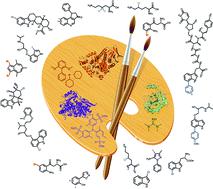当前位置:
X-MOL 学术
›
Chem. Soc. Rev.
›
论文详情
Our official English website, www.x-mol.net, welcomes your
feedback! (Note: you will need to create a separate account there.)
Halogenases: a palette of emerging opportunities for synthetic biology–synthetic chemistry and C–H functionalisation
Chemical Society Reviews ( IF 40.4 ) Pub Date : 2021-08-09 , DOI: 10.1039/d0cs01551b Charlotte Crowe 1 , Samuel Molyneux , Sunil V Sharma , Ying Zhang , Danai S Gkotsi , Helen Connaris , Rebecca J M Goss
Chemical Society Reviews ( IF 40.4 ) Pub Date : 2021-08-09 , DOI: 10.1039/d0cs01551b Charlotte Crowe 1 , Samuel Molyneux , Sunil V Sharma , Ying Zhang , Danai S Gkotsi , Helen Connaris , Rebecca J M Goss
Affiliation

|
The enzymatic generation of carbon–halogen bonds is a powerful strategy used by both nature and synthetic chemists to tune the bioactivity, bioavailability and reactivity of compounds, opening up the opportunity for selective C–H functionalisation. Genes encoding halogenase enzymes have recently been shown to transcend all kingdoms of life. These enzymes install halogen atoms into aromatic and less activated aliphatic substrates, achieving selectivities that are often challenging to accomplish using synthetic methodologies. Significant advances in both halogenase discovery and engineering have provided a toolbox of enzymes, enabling the ready use of these catalysts in biotransformations, synthetic biology, and in combination with chemical catalysis to enable late stage C–H functionalisation. With a focus on substrate scope, this review outlines the mechanisms employed by the major classes of halogenases, while in parallel, it highlights key advances in the utilisation of the combination of enzymatic halogenation and chemical catalysis for C–H activation and diversification.
中文翻译:

卤化酶:合成生物学、合成化学和 C-H 功能化的一系列新兴机遇
酶促生成碳-卤键是自然化学家和合成化学家用来调节化合物的生物活性、生物利用度和反应性的强大策略,为选择性 C-H 官能化提供了机会。最近,编码卤化酶的基因已被证明可以超越生命的所有领域。这些酶将卤素原子安装到芳香族和活性较低的脂肪族底物中,实现使用合成方法通常难以实现的选择性。卤化酶发现和工程方面的重大进展提供了酶工具箱,使这些催化剂能够在生物转化、合成生物学中随时使用,并与化学催化相结合以实现后期 C-H 功能化。本综述重点关注底物范围,概述了主要类别卤化酶所采用的机制,同时强调了利用酶卤化和化学催化相结合进行 C-H 活化和多样化的关键进展。
更新日期:2021-08-09
中文翻译:

卤化酶:合成生物学、合成化学和 C-H 功能化的一系列新兴机遇
酶促生成碳-卤键是自然化学家和合成化学家用来调节化合物的生物活性、生物利用度和反应性的强大策略,为选择性 C-H 官能化提供了机会。最近,编码卤化酶的基因已被证明可以超越生命的所有领域。这些酶将卤素原子安装到芳香族和活性较低的脂肪族底物中,实现使用合成方法通常难以实现的选择性。卤化酶发现和工程方面的重大进展提供了酶工具箱,使这些催化剂能够在生物转化、合成生物学中随时使用,并与化学催化相结合以实现后期 C-H 功能化。本综述重点关注底物范围,概述了主要类别卤化酶所采用的机制,同时强调了利用酶卤化和化学催化相结合进行 C-H 活化和多样化的关键进展。











































 京公网安备 11010802027423号
京公网安备 11010802027423号